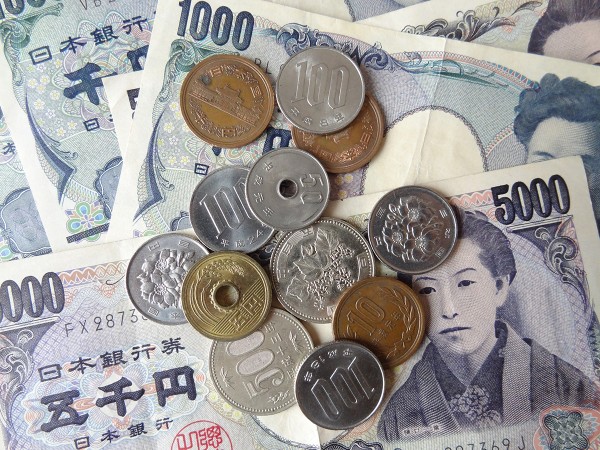 Japan has suffered from deflation on and off for more than 20 years. A problem with falling prices is that they discourage spending as people wait for prices to fall further. One of the three elements of the Japanese government’s macroeconomic policy (see Japan’s three arrows) has been expansionary monetary policy, including aggressive quantitative easing. A key aim of this is to achieve an inflation target of 2% and, hopefully, propel the economy out of its deflationary trap.
Japan has suffered from deflation on and off for more than 20 years. A problem with falling prices is that they discourage spending as people wait for prices to fall further. One of the three elements of the Japanese government’s macroeconomic policy (see Japan’s three arrows) has been expansionary monetary policy, including aggressive quantitative easing. A key aim of this is to achieve an inflation target of 2% and, hopefully, propel the economy out of its deflationary trap.
The latest news, therefore, from Japan would seem to be good: consumer prices rose 0.4% in June – the first rise for more than a year. But while some analysts see the rise in prices to be partly the result of a recovery in demand (i.e. demand-pull inflation), others claim that the inflation is largely of the cost-push variety as the weaker yen has increased the price of imported fuel and food.
 If Japanese recovery is to be sustained and broadly based, a growth in real wages should be a core component. As it is, real wages are not growing. This could seriously constrain the recovery. For real wages to grow, employers need to be convinced that economic recovery will be sustained and that it would be profitable to take on more labour.
If Japanese recovery is to be sustained and broadly based, a growth in real wages should be a core component. As it is, real wages are not growing. This could seriously constrain the recovery. For real wages to grow, employers need to be convinced that economic recovery will be sustained and that it would be profitable to take on more labour.
The success of the expansionary policy, therefore, depends in large part on its effect on expectations. Do people believe that prices will continue to rise? Do employers believe that the economy will continue to expand? And do people believe that their real wages will rise?
Articles
Japan prices turn higher, but BOJ’s goal remains tall order Reuters, Tetsushi Kajimoto and Leika Kihara (26/7/13)
How Japan Could Go from Deflation to Hyperinflation in a Heartbeat The Wall Street Journal, Michael J. Casey (24/7/13)
Japan Prices Rise Most Since ’08 in Boost for Abe Bloomberg, Toru Fujioka & Andy Sharp (26/7/13)
Japan central bank finds the pessimists come from within Reuters, Leika Kihara (26/7/13)
Japan’s Fiscal Crossroads: Will Abenomics Mean Tougher Changes? The Daily Beast, Daniel Gross (26/7/13)
Japan Economist Makes Rare Call to Tackle Debt The Wall Street Journal, Kosaku Narioka (25/7/13)
Japanese Consumer Prices Rise In Sign Of Some Success In Abe Economic Policy International Business Times, Nat Rudarakanchana (26/7/13)
Data
Bank of Japan Statistics Bank of Japan
Statistics Statistics Bureau of Japan
International sites for data Economics Network
Questions
- Distinguish between cost-push and demand-pull inflation? Do higher prices resulting from a depreciation of the currency always imply that the resulting inflation is of the cost-push variety?
- In the Japanese context, is inflation wholly desirable or are there any undesirable consequences?
- Consider whether a two-year time frame is realistic for the the Bank of Japan to achieve its 2% inflation target.
- What is meant by the output gap? Using sources such as the European Commission’s European Economy, AMECO database and the OECD’s Economic Outlook: Statistical Annex Tables (see sites 6 and 7 in the Economics Network’s links to Economic Data freely available online) trace the Japanese output gap over the past 10 years and comment on your findings.
- What supply-side constraints are likely to limit the rate and extent of recovery in Japan? What is the Japanese government doing about this (see the third arrow of Japan’s three arrows)?
 Japan’s general election on 16 December was won by the centre-right Liberal Democratic Party (LDP), led by Shinzo Abe. It gained a two-thirds majority in the lower house. It returns to power after losing to the Democratic Party in 2009. Previously it had been in office for most of the time since 1955.
Japan’s general election on 16 December was won by the centre-right Liberal Democratic Party (LDP), led by Shinzo Abe. It gained a two-thirds majority in the lower house. It returns to power after losing to the Democratic Party in 2009. Previously it had been in office for most of the time since 1955.
The LDP has promised to revive the flagging Japanese economy, which has been suffering from years of little or no growth and returned to recession last quarter. Economic confidence has been damaged by a dispute with China about the sovereignty over some small islands in the East China Sea. The economy, whose exports make up some 13% of GDP, has suffered from the global slowdown and a high yen. The yen has appreciated against the dollar by around 40% since 2007.
The economy has also suffered from the shutdown of all its nuclear reactors following the earthquake and tsunami last year. Nuclear power accounted for over 30% of the country’s electricity generation.
 Mr Abe promises to revive the economy through fiscal and monetary policies. He plans a fiscal stimulus package in early 2013, with increased government expenditure on infrastructure and other public-works. He also wants the Bank of Japan to increase its inflation target from 1% to 3% and to achieve this through various forms of monetary easing.
Mr Abe promises to revive the economy through fiscal and monetary policies. He plans a fiscal stimulus package in early 2013, with increased government expenditure on infrastructure and other public-works. He also wants the Bank of Japan to increase its inflation target from 1% to 3% and to achieve this through various forms of monetary easing.
The initial reactions of markets to the election result were favourable. The stock market rose and the yen fell.
However, as the following articles discuss, there are dangers associated with Mr Abe’s policies. The expansionary fiscal policy will lead to a rise in the country’s general-government debt, which, at some 240% of GDP, is by far the largest in the developed world. This could lead to a loss of confidence in Japanese debt and a fall in the price of bonds on the secondary markets and a rise in government borrowing costs. Also, a depreciation of the yen, while welcomed by exporters, would increase the price of imports, including food and raw materials.
Changing of guard in Japan as PM concedes vote CNN, Yoko Wakatsuki, Brian Walker, and Hilary Whiteman (17/12/12)
LDP Win Clears Pipes for Japan Fiscal Spigot Bloomberg Businessweek, Toru Fujioka (17/12/12)
Economic implications of Japan’s election Huffington Post (16/12/12)
Japan economy contracts again Taipei Times (11/12/12)
Japan elections: Shares rise and yen weakens on Abe win BBC News (17/12/12)
Shinzo Abe’s challenges in reviving Japan’s economy BBC News, Puneet Pal Singh (17/12/12)
Can Shinzo Abe Save Japan? Slate, Matthew Yglesias (30/11/12)
Deflation only natural when politicians refuse to fix oversupplied Japan Japan Times, Teruhiko Mano (17/12/12)
New Year messages from Japan BBC News, Stephanie Flanders (18/12/12)
Japan – Muddling On Or Growing Stronger? Seeking Alpha, Anthony Harrington (12/12/12)
Japanese government unveils £138bn stimulus package The Guardian (11/1/13)
Questions
- Using macroeconomic data from sources such as sites 6, 7 and 9 in the Economics Network’s Economic Data freely available online, describe Japan’s macroeconomic situation over the past 10 years.
- Why has the Japanese yen appreciated so much in recent years?
- What forms could monetary easing take in Japan?
- Why might it prove difficult to stimulate the Japanese economy through fiscal and monetary policies?
- What undesirable side-effects might result from expansionary fiscal and monetary policies?
- What structural weaknesses are there in the Japanese economy that have hindered economic growth? What policies might the new Japanese government pursue in tackling these structural weaknesses?
Each month the Monetary Policy Committee of the Bank of England meets to set Bank Rate – the Bank’s repo rate, which has a direct impact on short-term interest rates and an indirect effect on other interest rates, such as mortgage rates and bond yields. Ever since March 2009, Bank Rate has been 0.5%. So each month the MPC has met and decided to do nothing! The latest meeting on 4 and 5 May was no exception.
And it is not just the Bank of England. The Fed in the USA has kept interest rates at between 0 and 0.25% ever since December 2008. The ECB had maintained its main interest rate at 1% for two years from May 2009. Then last month (April) it raised the rate to 1.25%, only to keep it unchanged at that level at its meeting on 5 May.
So is all this ‘doing nothing’ on interest rates (or very little in the case of the ECB) a sign that the economies of the UK, the USA and the eurozone are all ticking along nicely? Are they in the ‘goldilocks’ state of being neither too hot (i.e. too much demand and excessive inflation) or too cold (i.e. too little demand and low growth, or even recession)? Or does the apparent inaction on interest rates mask deep concerns and divisions within the decision-making bodies?
The three central banks’ prime concern may be inflation, but they are also concerned about the rate of economic growth. If inflation is forecast to be above target and growth to be unsustainably high, then central banks will clearly want to raise interest rates. If inflation is forecast to be below target and economic growth is forecast to be low or negative, then central banks will clearly want to reduce interest rates.
But what if inflation is above target and will probably remain so and, at the same time, growth is low and perhaps falling? What should the central bank do then? Should it raise interest rates or lower them? This is the dilemma facing central banks today. With soaring commodity prices (albeit with a temporary fall in early May) and the economic recovery stalling or proceeding painfully slowly, perhaps keeping interest rates where they are is the best option – an ‘active’ decision, but not an easy one!
Articles
Central Banks Leave Rates Unchanged News on News (8/5/11)
European Central Bank set for a bumpy ride City A.M., Guy Johnson (9/5/11)
Euro Tumbles Most Against Dollar Since January on Rate Signal; Yen Climbs Bloomberg, Allison Bennett and Catarina Saraiva (7/5/11)
Rates outlook Financial Times, Elaine Moore (6/5/11)
Interest rates on hold amid fears economy is stalling Independent, Sean Farrell (6/5/11)
The decision to hold back on increasing interest rates may turn out to be wrong Independent, Hamish McRae (6/5/11)
 Bank of England: Inflation threat from fuel bills BBC News. Hugh Pym (11/5/11)
Bank of England: Inflation threat from fuel bills BBC News. Hugh Pym (11/5/11)
Andrew Sentance loses last battle over interest rates Guardian, Heather Stewart (5/5/11)
Interest rates: what the experts say Guardian (5/5/11)
King’s Defense of Record-Low Rates in U.K. Is Bolstered by Economic Data Bloomberg, Svenja O’Donnell (5/5/11)
BoE holds rates: reaction The Telegraph, Joost Beaumont, Abn Amro (5/5/11)
UK interest rates kept on hold at 0.5% BBC News (5/5/11)
Bank of England Signals Rate Increase This Year as Inflation Accelerates Bloomberg, Svenja O’Donnel (11/5/11)
ECB: Clearing the way for an Italian hawk? BBC News blogs: Stephanomics, Stephanie Flanders (5/5/11)
Ben and the Fed’s excellent adventure BBC News blogs: Stephanomics, Stephanie Flanders (27/4/11)
Inflation up. Growth down. Uncertainty everywhere BBC News blogs: Stephanomics, Stephanie Flanders (11/5/11)
Inflation report: analysts expecting a rate rise are wide of the mark Guardian, Larry Elliott (11/5/11)
May’s Inflation Report – three key graphs The Telegraph, Andrew Lilico (11/5/11)
The Errors Of The Inflation Hawks, Part I Business Insider, John Carney (9/5/11)
Errors of Inflation Hawks, Part II CNBC, John Carney (9/5/11)
Data and information
Inflation Report Bank of England
 Inflation Report Press Conference Webcast Bank of England (11/5/11)
Inflation Report Press Conference Webcast Bank of England (11/5/11)
Monetary Policy ECB
ECB Interest Rates ECB
Monetary Policy Federal Reserve
US interest rates Federal Reserve
Questions
- Why is it exceptionally difficult at the current time for central banks to “get it right” in setting interest rates?
- What are the arguments for (a) raising interest rates; (b) keeping interest rates the same and also embarking on another round of quantitative easing?
- Should central banks respond to rapidly rising commodity prices by raising interest rates?
- Why is inflation in the UK currently around 2 percentage points above the target?
- What is likely to happen to inflation in the coming months and why?
- Explain the following comment by John Carney in the final article above: “To put it differently, the textbook money multiplier doesn’t exist anymore. This means that Fed attempts to juice the economy by raising the quantity of reserves—the basic effect of quantitative easing—are bound to fail.”.
- What has been the recent relationship in the UK between (a) growth in the monetary base and growth in broad money; (b) growth in the monetary base and inflation and economic growth?
CPI inflation in the 12 months to September 2009 fell to 1.1% (from 1.6% in the 12 months to August). RPI inflation for the same period was -1.3%. In other words, retail prices actually fell by 1.3% in the 12 months to September. According to the ONS, “By far the largest downward pressure affecting the change in the CPI annual rate came from housing and household services. This was principally due to average gas and electricity bills, which were unchanged between August and September this year but rose a year ago when some of the major suppliers increased their tariffs.” (See below for link.)
If the CPI inflation rate falls below 1% (or rises above 3%), the Governor of the Bank of England is required to write a letter to the Chancellor of the Exchequer explaining why and also what the Bank of England intends to do about this. The Bank of England targets the forecast CPI inflation 24 months’ hence and attempts to achieve a rate of 2%. Normally, if the forecast rate is below 2%, the Monetary Policy Committee will decide to cut the rate of interest. The last Bank of England Inflation Report (August 2009) forecast CPI inflation of around 1.5% in 24 months’ time. If the November Inflation Report forecasts a similar figure, or even below, what can be done? Bank Rate is already at a historic low of just 0.5% and a further cut is unlikely to have much effect. Should the Bank of England, then, engage in another dose of quantitative easing? Perhaps the letter, if it has soon to be written, will make it clear.
UK consumer price inflation at 5-year low BusinessWeek (13/10/09)
Recession helps push inflation to five-year low Independent (14/10/09)
Inflation falls to lowest in five years Guardian (13/10/09)
Inflation dip likely to be short-lived Guardian (13/10/09)
Deflation, not inflation would be the bigger threat if the Conservatives do what they say Jeremy Warner blog, Telegraph (13/10/09)
Pound hit by falling UK inflation BBC News (13/10/09)
Pound hit by falling UK inflation (video) BBC News (13/10/09)
Pound pays price as inflation slides to five-year low Times Online (14/10/09)
Investors weigh risks of inflation and deflation Financial Times (12/10/09)
 Wage ‘catch up’ for public sector BBC Today Programme (14/10/09)
Wage ‘catch up’ for public sector BBC Today Programme (14/10/09)
Current data on UK Inflation (National Statistics)
Time series data (annual, quarterly and monthly) on UK prices and inflation Economic and labour Market Review (National Statistics)
Questions
- Why did the annual rate of CPI inflation fall so much in September 2009?
- Is the Bank of England Governor likely to have to write a letter (or letters) to the Chancellor in the coming months? Explain why or why not. What is likely to be the role of expectations in determining whether a letter has to be written?
- Why did the sterling exchange rate fall on the announcement of the inflation figure? What are likely to be the effects of this? What will determine the size of these effects?
- Why may additional amounts of quantitative easing be necessary in the coming months? How would a contractionary fiscal policy affect the desirability of additional quantitative easing?
 Japan has suffered from deflation on and off for more than 20 years. A problem with falling prices is that they discourage spending as people wait for prices to fall further. One of the three elements of the Japanese government’s macroeconomic policy (see Japan’s three arrows) has been expansionary monetary policy, including aggressive quantitative easing. A key aim of this is to achieve an inflation target of 2% and, hopefully, propel the economy out of its deflationary trap.
Japan has suffered from deflation on and off for more than 20 years. A problem with falling prices is that they discourage spending as people wait for prices to fall further. One of the three elements of the Japanese government’s macroeconomic policy (see Japan’s three arrows) has been expansionary monetary policy, including aggressive quantitative easing. A key aim of this is to achieve an inflation target of 2% and, hopefully, propel the economy out of its deflationary trap. If Japanese recovery is to be sustained and broadly based, a growth in real wages should be a core component. As it is, real wages are not growing. This could seriously constrain the recovery. For real wages to grow, employers need to be convinced that economic recovery will be sustained and that it would be profitable to take on more labour.
If Japanese recovery is to be sustained and broadly based, a growth in real wages should be a core component. As it is, real wages are not growing. This could seriously constrain the recovery. For real wages to grow, employers need to be convinced that economic recovery will be sustained and that it would be profitable to take on more labour.

